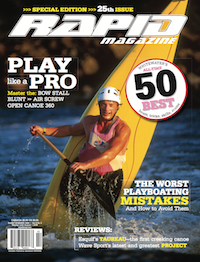Whether you are river running, creeking or hanging out at your favourite park and play spot, you’ll often come across friendly little holes that are ideal for 360s. Not only is the 360 an amusing pastime in its own right, learning this skill will also help you deal better with unplanned visits to unruly bigger holes.
 1. As you cross the foam pile, initiate an onside turn by applying a braking or ruddering stroke just behind your hip. This will get you into a side surf before your bow hits the green water coming into the hole. The green water hitting the upstream edge of your boat will try to flip you so you should have a slight downstream tilt. Side surf until you feel comfortable in the hole. Keep your strokes close to your body with an upright, balanced posture.
1. As you cross the foam pile, initiate an onside turn by applying a braking or ruddering stroke just behind your hip. This will get you into a side surf before your bow hits the green water coming into the hole. The green water hitting the upstream edge of your boat will try to flip you so you should have a slight downstream tilt. Side surf until you feel comfortable in the hole. Keep your strokes close to your body with an upright, balanced posture.
2. Move forward to the corner of the hole with a forward stroke or an angled blade on your high brace. As the bow hits the green water going past the hole it will be pushed downstream and initiate the spin. Help turn the boat and pull yourself toward the foam pile by doing a draw just ahead of your knee. Stay close to the peak of the foam when you initiate the turn to guard against the stern catching the green water when the boat is parallel to the current. This will also lift the ends out of the water and make the boat more manoeuvrable.
3. The crux of this move occurs when the boat is parallel to the current. As your bow passes beyond downstream, your off-side edge will become the new downstream edge so change the tilt by putting weight on your offside knee. Move your paddle to the downstream side as if you were doing an offside forward stroke with the shaft against the gunwale just in front of your knee. Turn your head and look back into the hole to see where you are going and to help the turning momentum.
4. When you complete the first 180, you’ll be in an offside side surf. Keep a steady downstream tilt to your offside and move the stern back toward the green water at the corner of the hole with a back stroke.
5. When the stern catches the green water and initiates the next part of the spin, plant your paddle on the upstream side of the boat in a ruddering position just behind your hip and close to the hull. This is tricky because you need to keep a downstream tilt on your offside. An upright and balanced body position is essential. When the boat is parallel to the current, change the tilt to onside and rudder into an onside side surf to complete the 360.
You may find turning the 360 toward your offside even easier. The tilt transitions are the same and only the strokes vary.
There are times when you might lean your body forward or back to keep the stern from hitting the green water, but aim to keep your body upright and balanced throughout the turn. Also, you’ll have more efficient strokes and a better body position if you keep your strokes close to your body. And remember, don’t get stuck looking downstream as the bow swings around the back of the hole. Quickly look over your shoulder and switch your tilt.
Mark Scriver is a former open canoe freestyle world champion and co-wrote The Thrill of the Paddle.




